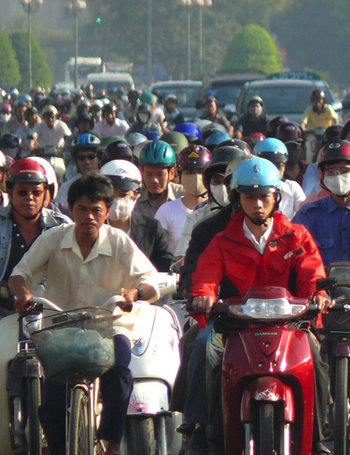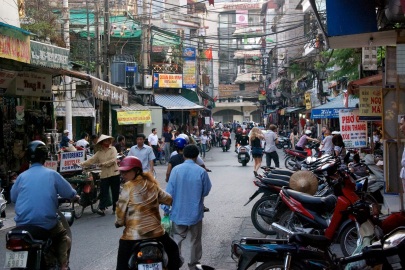Vietnam, Part 4: Emergence in Hanoi


This is the Duong Dong day market. Notice how many motorbikes are in this picture. That is INSIDE the market, like next to all the food. Northern Californian hippies wouldn’t be too thrilled…
Crossing the street in Vietnam is a feat of derring-do. I’m sure there are areas of China or Indonesia with an even greater degree of clusterfuckery, but Vietnam’s driving conditions are certainly deserving of mention. In most cities, the problem is congestion—how quickly you can move through the urban system—because too many cars, SUVs, and busses will collapse a roadway like a blood clot in an artery. However, when the dominant mode of transportation is the moped, a full-scale collapse is virtually impossible because mopeds are both maneuverable enough and compact enough to fit through impossible gaps in even the worst traffic. In these situations, the problem isn’t congestion; it’s chaos. If you’ve been to Rome, you’ve got an idea of what I’m talking about, but Vietnam is an order of magnitude more chaotic than Italy, Europe’s most moped addicted country.
Consider this: In Vietnam, a country of about 87.8 million people, there are an estimated 33.4 million mopeds or 1 unit for every 2.6 people. By comparison, Italy’s 61.3 million citizens only own 3.3 million mopeds or 1 unit per 18.6 people. When you consider that the two countries are essentially the same size (331,700 and 301,300 km squared, respectively), the problem becomes clear: there is an exceptionally high number of mopeds squeezed into a relatively small country. Thus, the clusterfuck.
Vietnam’s moped insanity is such a globally recognized “thing” that when you type “how many mopeds” into Google the top three queries are looking for information on Vietnam:
However, merely quantifying the volume of traffic that passes through the streets of Vietnam does not, at all, capture the experience of watching or—heaven forbid—entering the flow of traffic. First, having so many loosely regulated vehicles on the road affects the behavior of everyone—cars, buses, bikes and pedestrians alike. While the US government has defined what it means to maintain a “safe following distance,” Vietnamese drivers take a more libertarian approach to traffic laws, so any errant gaps between vehicles are filled in almost immediately by a motorbike or five. Lacking that cushion, everyone is therefore forced to drive much more slowly and much more defensively. Part of this heightened defensive style is a liberal use of the horn, not so much as an angry critique of bad behavior as an essential method for broadcasting your location to the cars around you. This unemotional honking fills the streets of Vietnam with courteous toots that seem to say, “Pardon me, but I’ll be passing on your right. Excuse me, but could you pull forward six inches, so I can fit past? Oh, careful! I’ll be taking this left, so maybe you shouldn’t turn just yet?” By their decibel count, the streets of Vietnam are louder than most American cities, but they somehow seem quieter because the honking has been stripped of its fuck-you.
Considering that, the roads of Vietnam must be the promised land of civility, right? Ha, nope. The Vietnamese people are totally civilized, but the composite organism that’s born everyday on every roadway is not bound by the laws of man. It’s a creature driven by biologic efficiency and spatial possibility, not stop signs and DMV handbooks.
Watching an intersection is like waiting for a neuron to trigger. The number of motorbikes grows until the pressure reaches an unknowable natural threshold, and they just fire across. No one person initiates the crossing; everyone just somehow intuits the right moment. Traffic on the main road stops or slows to a crawl as the traffic from the side road weaves through a jigsaw puzzle of stopped cars. While this is happening, through-traffic pressure builds and cross-traffic pressure drops, until the relationship is reversed. This cycle repeats hundreds of times an hour at every intersection.
Within the flow itself, the same organic principles that govern schooling fish govern the behavior of the motorbike. Yes, at times a lone maverick will brave the surge—even going so far as to drive the wrong direction down a busy three-lane street—but more often than not, loosely organized groups coalesce out of the chaos. Like a school of sardines, one of these groups will come together and break apart countless times in a single minute, as individuals react both to driving hazards—curves, potholes, on-coming cars—as well as the reactions to those hazards by their fellow drivers—breaking, acceleration, swerving. By reacting to reactions, information is transmitted from one side of the school to the other without explicit or conscious communication. Here’s how it works:
A bus merges into a lane being occupied by a motorbike. That crowded motorbike adjusts away from the bus and toward the next nearest motorbike, causing that second motorbike to adjust into the group, which causes the third nearest motorbike to adjust, and so on, until the whole group has reacted to something directly felt only by the first motorbike. In this way, the school makes room for all of its members without any one individual planning or directing the course correction.
This phenomenon, called “emergence,” occurs when the random, unintentional or self-interested actions of many separate organism total up to something that mimics or approximates collective thought. Like ant colonies or the cells in your brain, no one part is controlling the behavior of any other part. Simple, isolated reactions at the level of the individual result in a seemingly miraculous and remarkably complex process at the level of the group. (If you want to listen to an absolutely AMAZING Radiolab podcast about emergence, click here.)
But, with all this chaos, how can you cross the street in Vietnam? Although there are crosswalks, most cars and motorbikes don’t even treat them as a suggestion to slow down. Therefore, for your own safety, it’s best to think of pedestrian crossings as designated meeting points where tourists can stand around, looking anxious and confused.
What then is the secret to being an effective pedestrian? Just walk into traffic. Wait for a window, step off the curb, and don’t look back until you get to the other side. If you stop or hesitate or even LOOK at the oncoming traffic, you’ll put yourself in danger; if you keep your speed constant and don’t do anything unpredictable, the school of motorbikes will flow around you. React to the motorbikes while they’re reacting to you and you run the risk of initiating that awkward dance in which two people each try to let the other person pass first—“After you!” “No, after you!” “NO, after YOU!”—except rather than having a chuckle with a stranger, you’ll get smeared across the pavement. Looking at the drivers transforms them from parts in a larger and much smarter whole to self-interested individuals, hurtling along at 30 miles an hour while surrounded by dozens of potentially deadly hazards. In this case, too much caution disrupts the emergent state, which is actually the only protection a helpless pedestrian has.
Nota bene: this trick only works with motorbikes. Cars and cabs won’t swerve to avoid you, so try to time your crossings so that you, at no point, need to share your lane with a car. It’s like Frogger, except you can’t slow down or change direction. Once you get the hang of it, though, crossing the street in Vietnam is actually really easy. No waiting for lights; no questions of etiquette or deference; just follow your instincts and the traffic gods will take care of everything else*. Don’t hesitate, don’t be unpredictable, respect how the system works and you’ll make it across just fine.
*Please don’t go getting yourselves run over by cars. This is a general rule, which requires careful application in the real world, so be vigilant and use your own discretion. Also, if you’re really anxious, just wait until a local needs to cross and tag along.










